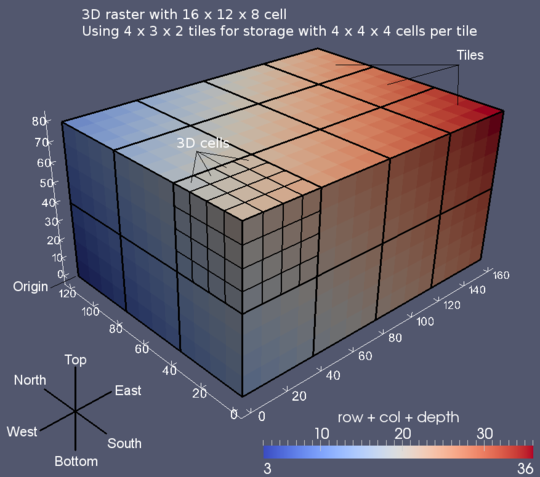
NAME
r3.out.ascii - Converts a 3D raster map layer into a ASCII text file.KEYWORDS
raster3d, export, output, voxel, conversion, ASCIISYNOPSIS
Flags:
- -h
- Suppress printing of header information
- -r
- Switch the row order in output from north->south to south->north
- -d
- Switch the depth order in output from bottom->top to top->bottom
- -c
- Print grass6 compatible format. Flags -d and -r are ignored.
- -m
- Use 3D raster mask (if exists) with input map
- --overwrite
- Allow output files to overwrite existing files
- --help
- Print usage summary
- --verbose
- Verbose module output
- --quiet
- Quiet module output
- --ui
- Force launching GUI dialog
Parameters:
- input=string [required]
- 3D raster map to be converted to ASCII
- output=name
- Name for ASCII output file
- precision=integer
- Number of decimal places for floats
- Options: 0-20
- Default: 8
- null_value=string
- String representing NULL value
- Default: *
Table of contents
DESCRIPTION
r3.out.ascii exports a 3D raster map in ASCII format. The input parameter is a valid 3D raster map in the current mapset search path. The output parameter is the name of an ASCII file which will be written in the current working directory.If output is not specified then standard output (stdout) is used. The -h flag may be used to suppress header information. The module is sensitive to region settings (set with g.region).
The -c flag will create GRASS 6 r3.in.ascii compatible output.
NOTES
The default format of the exported ASCII file is equivalent to that required by r3.in.ascii. In particular, files output by r3.out.ascii with header information may be converted back to 3D raster maps with r3.in.ascii.The format of the ASCII file is:
version: "grass7" order: "nsbt" or "nstb" or "snbt" or "sntb" north: floating point south: floating point east: floating point west: floating point top: floating point bottom: floating point rows: integer cols: integer levels: integer
west -> east for columns north -> south for rows bottom -> top for depths
This header is followed by the cell values in floating point format organized in rows with constant col and level coordinate. The rows are organized by constant level coordinate. Individual cell values are separated by space or CR. Cell values are exported as a series of horizontal slices in row-major order. The data starts with the upper left corner (NW) at the bottom of the data set. The values at the following coordinates are exported:
(x, y + rows, z) (x + 1, y + rows, z) ... (x + cols, y + rows, z)
(x, y + rows, z) (x + 1, y + rows - 1, z) ... (x + cols, y + rows - 1, z)
. . .
. . .
. . .
(x, y, z + depths) (x + 1, y, z + depths) ... (x + cols, y, z + depths)
Supported orders are:
- nsbt: north -> south and bottom -> top ordering which is the default (no flags)
- snbt: south -> north and bottom -> top ordering using -r flag
- nstb: north -> south and top -> bottom ordering using -d flag
- sntb: south -> north and top -> bottom ordering using -rd flag
The internal storage scheme of 3D raster maps is visualized in the following picture:

One level maps can be imported with r.in.ascii (2D raster) using the default nsbt order and removing the header lines "version", "order", "top", "bottom" and "levels".
EXAMPLES
We define a small region with 4 columns, 3 rows and 2 depths (4x3x2) and export it using different ordering definitions:g.region res3=1 t=2 b=0 w=0 e=4 s=0 n=3 r3.mapcalc "simple_example = row() + col() + depth()"
r3.out.ascii input=simple_example dp=0 version: grass7 order: nsbt north: 3.000000 south: 0.000000 east: 4.000000 west: 0.000000 top: 2.000000 bottom: 0.000000 rows: 3 cols: 4 levels: 2 3 4 5 6 4 5 6 7 5 6 7 8 4 5 6 7 5 6 7 8 6 7 8 9
r3.out.ascii input=simple_example dp=0 -r version: grass7 order: snbt north: 3.000000 south: 0.000000 east: 4.000000 west: 0.000000 top: 2.000000 bottom: 0.000000 rows: 3 cols: 4 levels: 2 5 6 7 8 4 5 6 7 3 4 5 6 6 7 8 9 5 6 7 8 4 5 6 7
r3.out.ascii input=simple_example dp=0 -d version: grass7 order: nstb north: 3.000000 south: 0.000000 east: 4.000000 west: 0.000000 top: 2.000000 bottom: 0.000000 rows: 3 cols: 4 levels: 2 4 5 6 7 5 6 7 8 6 7 8 9 3 4 5 6 4 5 6 7 5 6 7 8
r3.out.ascii input=simple_example dp=0 -rd version: grass7 order: sntb north: 3.000000 south: 0.000000 east: 4.000000 west: 0.000000 top: 2.000000 bottom: 0.000000 rows: 3 cols: 4 levels: 2 6 7 8 9 5 6 7 8 4 5 6 7 5 6 7 8 4 5 6 7 3 4 5 6
SEE ALSO
r3.in.ascii, r.out.ascii, g.regionAUTHORS
Roman Waupotitsch, Michael Shapiro, Helena Mitasova, Bill Brown, Lubos Mitas, Jaro Hofierka, Sören GebbertSOURCE CODE
Available at: r3.out.ascii source code (history)
Accessed: Sunday Jan 22 07:36:52 2023
Main index | 3D raster index | Topics index | Keywords index | Graphical index | Full index
© 2003-2023 GRASS Development Team, GRASS GIS 8.2.1 Reference Manual